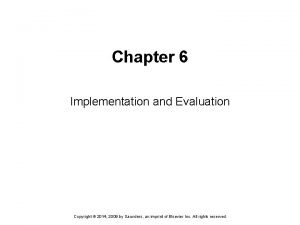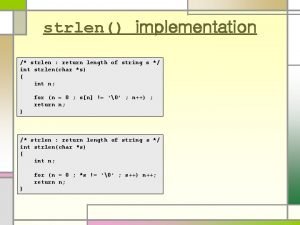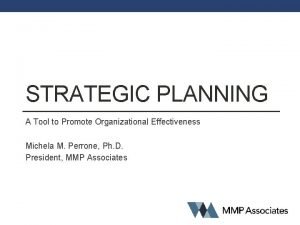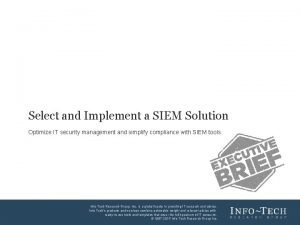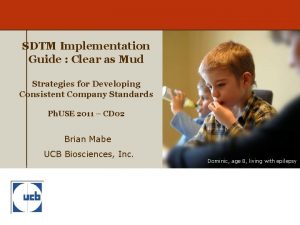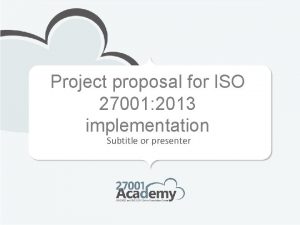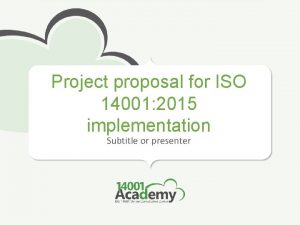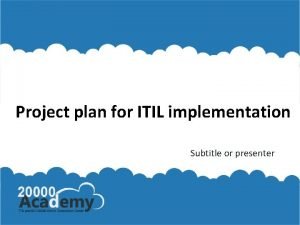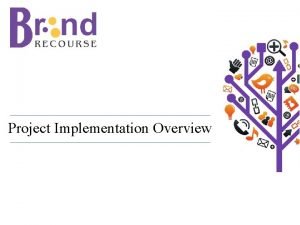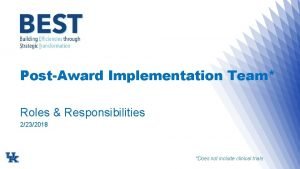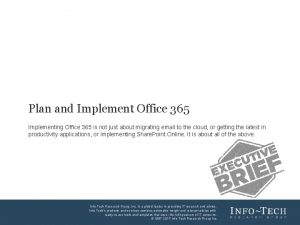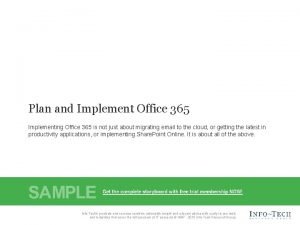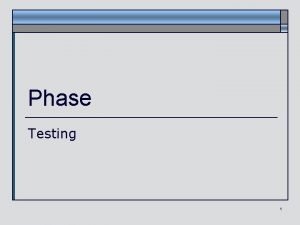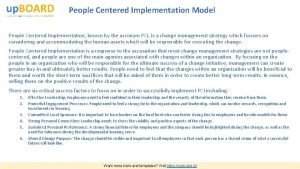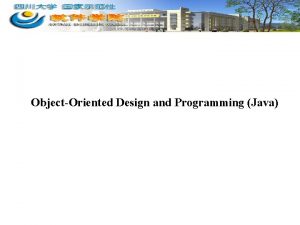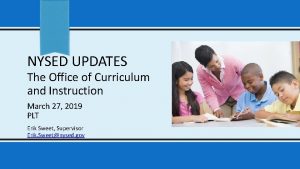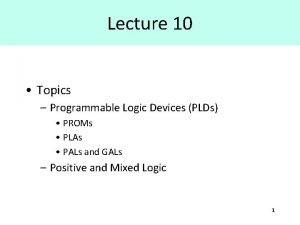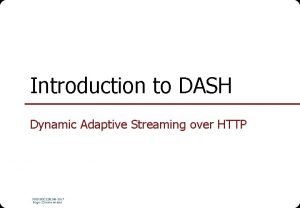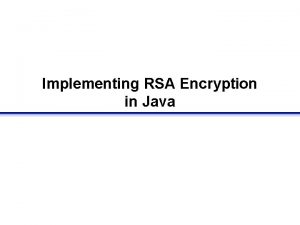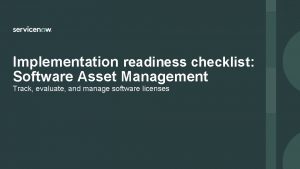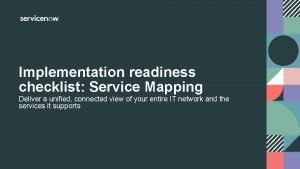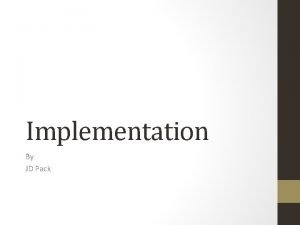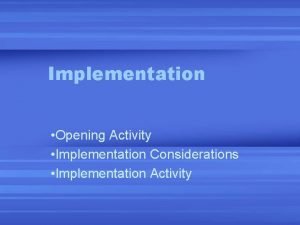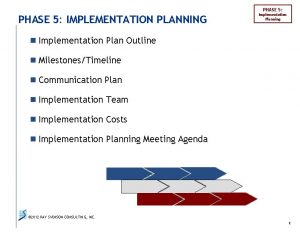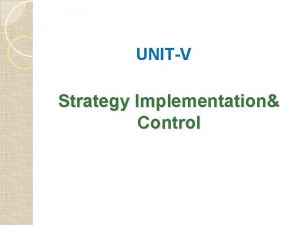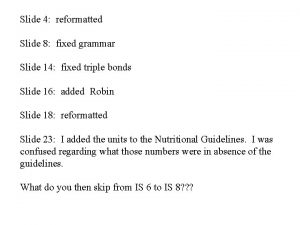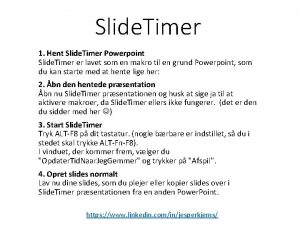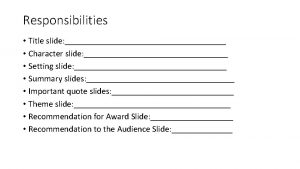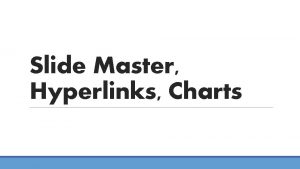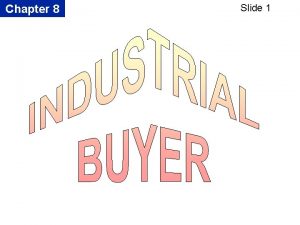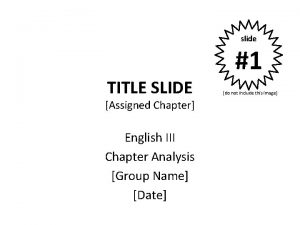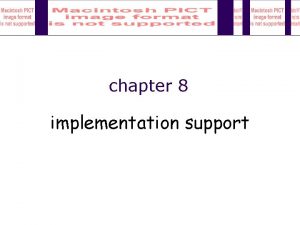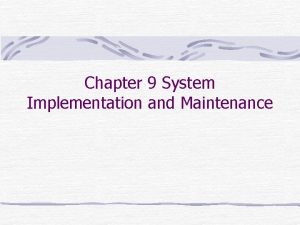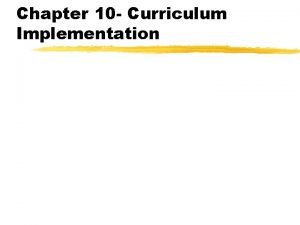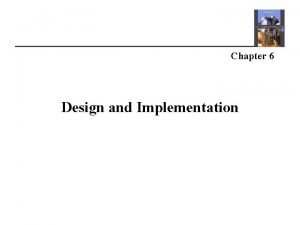Slide 12 1 Chapter 12 Implementation Slide 12





































- Slides: 37

Slide 12. 1 Chapter 12 Implementation

Slide 12. 2 Learning outcomes • Produce a plan to minimize the risks involved with the launch phase of an e-business application • Define a process for the effective maintenance of an e-business system • Produce a simple web page with links to other pages • Create a plan to measure the effectiveness of an e-business application.

Slide 12. 3 Management issues • What actions can we take to minimize the risks of implementation? • How do we achieve transition from previous systems to a new e-business system? • What techniques are available to measure the success of our implementation?

Slide 12. 4 Implementation • The creation of a system based on analysis and design documentation.

Slide 12. 5 Implementation Activities • The creation of the system modules by coding and scripting • Module integration • Testing and changeover to the live system

Slide 12. 6 Maintenance Phase • Commences after system is live

Slide 12. 7 Dynamic e-business application • The application is continuously updated in response to competitive forces.

Slide 12. 8 Maintenance Activities Involves • measurement of an information system’s effectiveness and • updating to correct errors or • introduce new features necessary to improve its value to the organization.

Slide 12. 9 Relationship between analysis, design, implementation and maintenance

Slide 12. 10 System implementation issues • • • Acquisition techniques Site implementation tools Content management and updating System changeover Localization Evaluation and monitoring.

Slide 12. 11 Sequencing of implementation and maintenance for the dynamic e-business application Figure 12. 1

Slide 12. 12 Acquisition Method • Defines whether the system is purchased outright or developed from scratch.

Slide 12. 13 Systems acquisition options • • Bespoke development. The e-commerce system is developed from scratch. Off-the-shelf (packaged). An existing system is purchased from a solution vendor. In the e-business context this approach is often achieved by external hosting via an applications service provider. Hosted Solution. Standard software that is managed externally on the supplier’s server. Tailored off-the shelf development. The off-the-shelf system is tailored according to an organization’s needs.

Slide 12. 14 Development of web-based content and services • Static web content • Dynamic web content • Knowledge of HTML- creating a simple HTML page • Forms • Page Layout

Slide 12. 15 Figure 12. 3 Possible web page layout options

Slide 12. 16 Developing Dynamic Web Content • • Scripting Languages Client side scripting Server side scripting Java. Script, VBScript, Perl, ASPs, . Net

Slide 12. 17 Figure 12. 5 Using scripting to produce dynamic web content form processing

Slide 12. 18 Testing Has 2 main objectives: • To check for non conformance with the business and user requirements • To identify bugs or errors

Slide 12. 19 Test Specification • A description of the testing process and tests to be performed.

Slide 12. 20 Testing Type of testing Description Developer tests Code level tests performed by developers of modules Feasibility testing Tests a new approach, often near the start of a project to make sure it is acceptable in terms of user experience Module (component) tests Checks individual modules have the correct functionality i. e. correct outputs are produced for specified inputs (black-box testing) Integration testing Checks interactions between groups of modules System testing Checks interactions between all modules in the system Database transaction taken Can the user connect to the database and are transactions executed correctly Performance/capacity testing Tests the speed of the system under high load Usability testing Check that the system is easy to use and follows the conventions of user-centred design described in Chapter 11 Acceptance tests Checks the system is acceptable for the party that commissioned it Content or copy testing Tests the acceptability of copy from a marketing view

Slide 12. 21 Different tasks involved in maintenance 1. 2. 3. 4. 5. 6. Write Review Correct Publish(to test environment) Test Publish( to live environment)

Slide 12. 22 Figure 12. 6 A content update review process

Slide 12. 23 Figure 12. 7 Typical structures of an e-commerce site steering group

Slide 12. 24 Management issues with maintenance • Deciding on the frequency and scope of content updating • Process for managing maintenance of the site and responsibilities for updating • Selection of content management system • Testing and communicating changes made • Integration with monitoring and measurement systems • Managing content in the global organization.

Slide 12. 25 Measuring and Improving Performance of ebusiness Systems 1. Create performance management system 2. Define the performance metrics framework 3. Tools and techniques for collecting metrics and summarizing results

Slide 12. 26 Figure 12. 8 A summary of the performance measurement process

Slide 12. 27 The five diagnostic categories for e-marketing measurement from the framework presented by Chaffey (2000) Figure 12. 9

Slide 12. 28 Figure 12. 10 Attrition through e-commerce site activities

Slide 12. 29 Tools and techniques for collecting metrics • • • Collecting site visitor activity Hit Log file analyser Page impression Unique visitors

Slide 12. 30 Figure 12. 11 Examples of different measures of visitor volume to a web site

Slide 12. 31 Selecting a web analytics tool • The types of data that need to be integrated within the performance management system: Operational Data Tactical Data Strategic Data • Web Analytics tool should integrate various data sources.

Slide 12. 32 Different types of data within a performance management system for Internet marketing Figure 12. 12

Slide 12. 33 Summary • Implementation is an iterative process of managing changes involving analysis, design, testing and review as part of an evolutionary prototyping process. • Maintenance is a continuous process of monitoring, assessing required changes and then implementing them using evolutionary prototyping.

Slide 12. 34 s • Simple web pages are developed in static HTML. Most e-business systems require dynamic pages that are implemented using client- and server-side scripting, of which the most popular are Java. Script and ASP.

Slide 12. 35 • Testing has two main objectives: first to check for non conformance with the business and user requirements, and second to identify bugs or errors. • There are many specialized techniques to test either part of the system or all of the system.

Slide 12. 36 • Content management requires a clearly defined update process and responsibilities according to different types of changes required. • Measurement also requires process and responsibilities and also a measurement framework.

Slide 12. 37 • Selection of appropriate web analytics tools is important to assess the effectiveness of ecommerce.
 What are the basic dance steps in heel and toe polka
What are the basic dance steps in heel and toe polka Chapter 6 implementation and evaluation
Chapter 6 implementation and evaluation Slide divide method
Slide divide method Strlen implementation c
Strlen implementation c Organizing for action strategy implementation
Organizing for action strategy implementation Strategy implementation
Strategy implementation Strategic implementation plan
Strategic implementation plan Siem deployment project plan
Siem deployment project plan Cdisc sdtm implementation guide
Cdisc sdtm implementation guide Swot analysis of school improvement plan
Swot analysis of school improvement plan Sas model implementation platform
Sas model implementation platform Ra10912
Ra10912 Implementation of qltc
Implementation of qltc Steps in policy making
Steps in policy making Iso 27001 implementation proposal
Iso 27001 implementation proposal Iso 14001 implementation project plan
Iso 14001 implementation project plan Itil implementation project plan
Itil implementation project plan Sms marketing ppt
Sms marketing ppt Implementation team roles and responsibilities
Implementation team roles and responsibilities Office 365 implementation roadmap
Office 365 implementation roadmap Office 365 implementation roadmap
Office 365 implementation roadmap Implementation phase definition
Implementation phase definition People centred implementation
People centred implementation Intune rollout plan
Intune rollout plan Ofsted mythbuster
Ofsted mythbuster Program to an interface, not an implementation
Program to an interface, not an implementation Nyssls implementation timeline
Nyssls implementation timeline Network design and implementation
Network design and implementation Power bi governance good practices
Power bi governance good practices Prom, pla, pal and gal are considered like?
Prom, pla, pal and gal are considered like? Frank maurer
Frank maurer Dynamic adaptive streaming over http implementation
Dynamic adaptive streaming over http implementation Rsa algorithm java
Rsa algorithm java Implementation of hrd program
Implementation of hrd program Product roadmap in sharepoint
Product roadmap in sharepoint Implementation readiness checklist
Implementation readiness checklist Implementation readiness checklist
Implementation readiness checklist Non lease components
Non lease components

